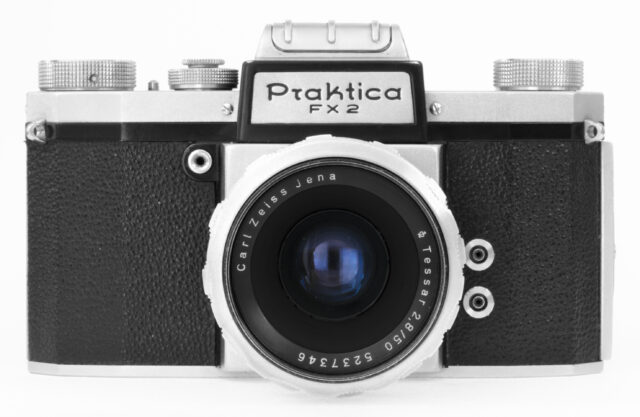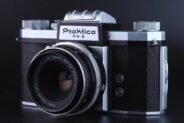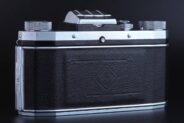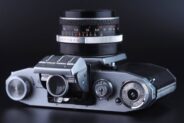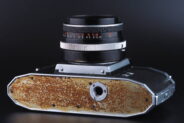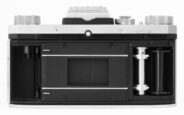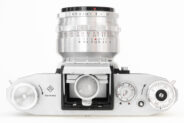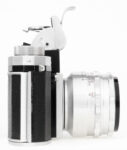Announced
Production status
System
Contax/Praktica system cameras
- Contax D
- Contax E
- Contax F
- Contax FB
- Contax FBM
- Contax FM
- Contax S
- Pentaflex SL
- Praktica
- Praktica DTL 2
- Praktica DTL 3
- Praktica EE 2
- Praktica EE 3
- Praktica FX
- Praktica FX 2
- Praktica III
- Praktica IV (early)
- Praktica IV (late)
- Praktica IV B
- Praktica IV BM
- Praktica IV F
- Praktica IV FB
- Praktica IV M
- Praktica L
- Praktica L 2
- Praktica LB
- Praktica LB 2
- Praktica LLC
- Praktica LTL
- Praktica LTL 2
- Praktica LTL 3
- Praktica mat
- Praktica MTL 3
- Praktica MTL 5
- Praktica MTL 50
- Praktica MTL 5B
- Praktica nova
- Praktica nova B
- Praktica PL electronic
- Praktica PL nova I
- Praktica PL nova IB
- Praktica PLC 2
- Praktica PLC 3
- Praktica super TL
- Praktica super TL 2
- Praktica super TL 3
- Praktica super TL1000
- Praktica super TL500
- Praktica V F
- Praktica V FB
- Praktica VLC
- Praktica VLC 2
- Praktica VLC 3
Praktica FX 2
aka Praktica FX 3
35mm MF film SLR camera • Discontinued
Specification
| Format: | |
| 35mm full frame | |
Film type: | 135 cartridge-loaded film |
| M42 [45.5mm] | |
| Shutter: | |
Type: | Focal-plane |
Model: | Mechanical |
Speeds: | 1/2 - 1/500 + B |
| Exposure: | |
Exposure metering: | None |
Exposure modes: | Manual |
| Physical characteristics: | |
Weight: | 620g |
Dimensions: | 150x80x40mm |
Manufacturer description #1
NOW AVAILABLE... THE NEW 1956 Praktica FX model 2
The new 1956 Praktica FX2, with its single-lens reflex system, is a significant advancement in photography, and a delight to photographers the world over.
The new 1956 Praktica FX2 places at your command an exclusive array of precision features including the newly designed ultra-modern Push-Button finder to give fast and accurate focusing, and brilliant images on the finder ground glass. For close-up work and photomicrography, a new powerful "hide-away" magnifier is provided - an invaluable aid for extra-critical focusing. Optional, for action and sports, a new eye-level prismatic finder slips snugly and compactly into the new Viewfinder.
LOOK AT THESE PRAKTICA FX2 FEATURES:
- Original factory synchronization for regular and electronic flash.
- Wide range of instantaneously interchangeable wide angle and telephoto lenses from 28-mm to 800-mm.
- Newly designed ultra-modern push-button waist-level reflex viewfinder to give fast and accurate focusing.
- Newly designed eye-level prismatic view finder assures a vertically and horizontally correct picture with sides unreversed*.
- Focal plane shutter with ten settings... 1/500, 1/200, 1/100, 1/50, 1/25, 1/10, 1/5, 1/2 second and Bulb, and new additional speed equal to 1/40 for electronic strobe.
- Close-ups and Microphotography without special viewing attachments.
- Built-in powerful hide-away magnifier for critical focusing.
- Coupled film transport and shutter cocking.
- Double exposure prevention... intentional double exposures possible.
- Back removes quickly for easy loading.
* optional, at additional cost.
Manufacturer description #2
FIRST WITH INTERNAL AUTOMATIC IRIS IN A POPULAR-PRICED SINGLE LENS REFLEX
THE NEW 1957 Praktica FX2
Here's the most exciting news of the year for the photographic fan who's yearned for a superb automatic single-lens reflex camera in the popular-priced range.
Now, the popular-priced Praktica FX2 - already established as the best dollar-for-dollar value in the fine camera field - comes to you in a brand-new 1957 model with internally-coupled automatic lenses. These permits you to focus at full aperture, for maximum light. Then, when you press the shutter release, the iris diaphragm automatically closes to the selected aperture and the picture is simultaneously taken. This feature is usually found in higher-priced cameras only.
With the new, 1957 Praktica FX2, the whole wide world of photography is within your grasp. Fine portrait work, carefully composed scenic shots, fast-action pictures. You get all the advantages of 35-mm. photography - easy handling, speed and film economy. You get the unique benefits of single-lens photography - ground glass focusing that delivers ideal control of composition and lighting - through-the-lens visibility - freedom from parallax error - a perfect preview of the picture you're going to get!
No Other Comparably Priced Camera Gives You All These Features
- Internally automatically-coupled iris diaphragm
- Lens interchangeability
- 1/500 to 1/2 second speeds - Focal Plane shutter
- Built-in waist-level viewfinder with achromatic magnifier
- Accepts accessory Prismatic eye-level viewfinder
- Synchronized for regular and electronic flash
- Coupled film transport, shutter cocking and frame counting.
Manufacturer description #3
The miniature reflex camera "Praktica FX 2", a masterpiece of German craftsmanship, discloses to the amateur and professional photographer the extremely versatile and wondrous territories of photography.
The advantages of the single-lens reflex camera system become particularly obvious in the Praktica FX 2. Already before the exposure, the subject is visible, free from parallax error, in the ground-glass image, making it possible to predetermine depth of field and picture composition with utmost accuracy.
Interchangeable lenses of various focal lengths in the Praktica FX 2, some of them with automatic diaphragm, open up a wide range of applicability for tele-photo and close-up exposures.
To complete the finder system, a supplementary reversing prism can be inserted into the finder hood, revealing an upright, laterally correct image.
***
Technical Data
Lenses: 35 to 500 mm focal length with speeds ranging from f/1.5 to f/8. All lenses are coated.
Shutter: Focal-plane shutter, 1/2 to 1/500 sec. and B, synchronized for electronic and regular flash.
Finder System: Reflex finder with image field lens and magnifier for critical focusing (free from parallax). Built-in sports finder. Insertable reversing prism.
Film Transport: Coupled with shutter wind, no unintentional double exposures or blanks.
Manufacturer description #4
PRAKTICA FX2 allowed a pentaprism to be inserted into the reflex finder hood for eye level viewing. This model introduced semi-automatic aperture setting and the latest version had fully automatic iris control. This latter was offered in some countries as the Praktica FX3. The latest version of the Praktica F.X2 (dot between the F and X!) had, in addition to X synchronization, also the now international standard F synchronization for flash bulbs.
Manufacturer description #5
The all-new Praktica automatic features an amazing, fool-proof mechanism - found up to now only in high-priced cameras. It provides ultra-bright, razor-sharp focusing at maximum lens aperture and then automatically closes the lens to any previously selected aperture when you press the shutter release button. It eliminates over-exposed pictures because the photographer forgot to stop the camera down to the proper aperture after focusing. It eliminates fumbling with manual-type lenses.
25 other luxury features make the Praktica automatic the most desirable 35mm Single-lens Reflex Camera in its price class!
- Accepts All lenses - Standard, Pre-set and Automatic
- Through-the-Iens Reflex Focusing
- New "Scoop" Push-button Viewfinder
- Direct-vision Sportsfinder
- Accepts Accessory Prismatic Eye-level Viewfinder
- New Hide-away Color-corrected 6-power Magnifier
- Focal-plane Shutter with 10 Settings
- Coupled Film Transport and Shutter Setting
- Automatic Exposure Counter
- Interchangeable Lenses
- Internal Flash Synchronization
- Special Shutter Setting for Electronic Flash
- Double Exposure Prevention
- Intentional Double Exposure
- Engraved Depth-of-field Scale
- Engraved Distance Scale
- Built-in Metal Neckstrap lugs
- Handy Front-located Shutter Release
- Cable Release Socket with Standard Thread
- Tripod Socket with Standard 1/4 x 20 American Thread
- Removable Back with "Snap-on" lock
- Compact- 6"x3"x3"
- High-precision Design and Manufacture
- Light - Weighs Only 24 Ounces without Lens
- Accepts a Host of Custom-crafted Accessories
INTERNAL COUPLING FOR LENSES WITH AUTOMATIC DIAPHRAGMS. Take your choice of three world-famous coated lenses having automatic diaphragms. Both are especially designed for use with the Praktica INTERNAL automatic coupling. When the shutter release is pressed, the new internal mechanism swiftly and automatically closes the lens diaphragm down to a pre-selected stop and simultaneously trips the shutter. There is no external apparatus, no additional strain or pressure on the shutter release.
THROUGH-THE-LENS REFLEX FOCUSING permits you to preview your subject in the viewfinder through the same lens that is used for taking the picture. There can be no parallax error of any kind. You can inspect the subject for color and composition in detail, focus with razor-sharp accuracy and observe the depth-of-field. When the shutter is released, the image is registered on the film exactly as you see it in the viewfinder. The Praktica automatic Reflex Focusing System is ideal for candid shots, sports, portraits, news, industrial, medical, dental, educational and scientific photography.
"SCOOP" PUSH-BUTTON WAIST-LEVEL VIEWFINDER snaps into viewing position to give a brilliant, upright image on the ground glass, free of reflections and interference from overhead light. You can sight in any direction - in either horizontal or vertical format.
HIDE-AWAY COLOR-CORRECTED 6-POWER MAGNIFIER snaps into place directly over the center of the ground glass with the flip of a tab. It provides for extra-critical focusing and is an invaluable aid in close-ups and photomicrography.
ACCESSORY PRISMATIC EYE-LEVEL VIEWFINDER, available as additional equipment, slips into place easily and swiftly over the camera's regular viewfinder. It provides an upright, unreversed image and allows the photographer to follow action. It is particularly useful in sports and action photography.
DIRECT-VISION SPORTSFINDER permits direct viewing of subject for sports and action shots.
FOCAL PLANE SHUTTER provides shutter settings of 1/500, 1/200, 1/100, 1/50, 1/25, 1/10, 1/5, 1/2 second and Bulb, plus a special setting of 1/40 second for electronic flash. All shutter speeds, fast and slow, are set from a dual-control dial on the top of the camera.
COUPLED FILM TRANSPORT AND SHUTTER SETTING permits taking picture after picture with great rapidity. A single knob winds the shutter, positions the mirror, advances the film and sets the automatic exposure counter.
DOUBLE EXPOSURE PREVENTION is built into the Praktica automatic Film-Advance-and-Shutter-Set system. Intentional double exposures can be made quickly and easily for such uses as trick effects, titling for slides, and so on.
INTERCHANGEABLE LENSES. The Praktica automatic features a screw-in lens mount which permits swift interchangeability of lenses. A wide variety of telephoto and wide angle lenses are available to meet every photographic need.
INTERNAL FLASH SYNCHRONIZATION. The Praktica automatic features internal flash synchronization with two flash outlets on the front of the camera next to the lens. The lower outlet is for standard focal plane flashbulbs, the upper outlet is for electronic flash units. A special shutter setting of 1/40 second is provided for electronic flash.
ENGRAVED SCALES. All Praktica lenses have engraved scales for Depth-of-Field and distance in both feet and meters.
BUlLT-IN LUGS accept Praktica accessory flexible metal neck-chains.
SHUTTER RELEASE is located on the top part of the camera next to the lens and has a cable release socket threaded for standard tips.
TRIPOD SOCKET is located on the bottom of the camera and accepts standard 1/4 x 20 American tripod screws.
REMOVABLE BACK makes loading simple. New positive-action snap-on lock quickly secures back on camera.
COMPACT and LIGHT. Camera is only 6" long, 3" high and 3" deep, weighs only 24 ounces without the lens.
SIMPLICITY OF DESIGN makes operation a miracle of ease. High precision engineering and manufacture assures a lifetime of trouble-free operation.
From the editor
Along with the Contax F, released in the same year 1956, it was the world's first 35mm SLR camera with internal automatic aperture stop-down but without instant-return mirror.
Only 13,490 units were produced from February 1956 to June 1956. This was a version with single coaxial flash socket.
Another 34,062 units were produced from June 1956 to February 1958. This was a version with two coaxial flash sockets.
For export, a version with two coaxial flash sockets was produced in 25,790 units under the name "Praktica FX 3".
***
There were also "F.X 2" and "FX 2." versions with a slightly modified F synchronization.
Only 29,110 units were produced from March 1958 to June 1959.
For export, these camera were produced in 19,971 units under the names "F.X 3" or "FX 3." from March 1958 to June 1959.
Similar cameras (115)
35mm full frame • Manual focus • Film • Singe-lens reflex • M42 mount
| Model | Shutter | Metering | Modes | Year |
|---|---|---|---|---|
| Alpa Si 2000 | E, 1/2000 | TTL • WA | AM | 1977 ● |
| Argus CR-3E | E, 1/2000 | TTL • WA | M | ● |
| Argus/Cosina STL 1000 | M, 1/1000 | TTL • WA | M | 1970 ● |
| Asahi Pentax aka Tower 26 |
M, 1/500 | -- | M | 1957 ● |
| Asahi Pentax ES aka Asahi Pentax Electro Spotmatic aka Honeywell Pentax ES |
E, 1/1000 | TTL • OA | AM | 1971 ● |
| Asahi Pentax ES II aka Honeywell Pentax ES II |
E, 1/1000 | TTL • OA | AM | 1973 ● |
| Asahi Pentax K aka Tower 29 |
M, 1/1000 | -- | M | 1958 ● |
| Asahi Pentax S aka Tower 26 |
M, 1/500 | -- | M | 1958 ● |
| Asahi Pentax S1 aka Honeywell Heiland Pentax H-1 aka Honeywell Pentax H1 |
M, 1/500 | -- | M | 1961 ● |
| Asahi Pentax S1a aka Honeywell Heiland Pentax H-1a aka Honeywell Pentax H1a |
M, 1/500 | -- | M | 1962 ● |
| Asahi Pentax S2 aka Honeywell Heiland Pentax H-2 aka Honeywell Pentax H2 |
M, 1/1000 | -- | M | 1959 ● |
| Asahi Pentax S3 aka Honeywell Heiland Pentax H-3 aka Honeywell Pentax H3 |
M, 1/1000 | -- | M | 1961 ● |
| Asahi Pentax Spotmatic aka Honeywell Pentax Spotmatic |
M, 1/1000 | TTL • WA | M | 1964 ● |
| Asahi Pentax Spotmatic F aka Honeywell Pentax Spotmatic F |
M, 1/1000 | TTL • OA | M | 1973 ● |
| Asahi Pentax Spotmatic II | M, 1/1000 | TTL • WA | M | 1971 ● |
| Asahi Pentax Spotmatic SL aka Honeywell Pentax Spotmatic SL |
M, 1/1000 | -- | M | 1968 ● |
| Asahi Pentax Spotmatic SP 1000 aka Honeywell Pentax Spotmatic SP 1000 |
M, 1/1000 | TTL • WA | M | 1974 ● |
| Asahi Pentax Spotmatic SP 500 aka Honeywell Pentax Spotmatic SP 500 |
M, 1/500 | TTL • WA | M | 1971 ● |
| Asahi Pentax SV aka Honeywell Pentax H3v |
M, 1/1000 | -- | M | 1962 ● |
| Chinon AM-3 | M, 1/1000 | TTL • WA | M | ● |
| Chinon CE II Memotron | E, 1/2000 | TTL • WA | AM | 1975 ● |
| Chinon CE Memotron | E, 1/2000 | TTL • WA | AM | 1973 ● |
| Chinon CE-3 Memotron | E, 1/1000 | TTL • WA | AM | 1977 ● |
| Chinon CM-1 | M, 1/1000 | TTL • WA | M | ● |
| Chinon CM-3 | M, 1/1000 | TTL • WA | M | 1977 ● |
| Chinon CS | M, 1/1000 | TTL • WA | M | 1976 ● |
| Chinon CS-4 | M, 1/1000 | TTL • WA | M | ● |
| Chinon CX | M, 1/1000 | TTL • WA | M | ● |
| Chinon CX II | M, 1/1000 | TTL • WA | M | 1976 ● |
| Chinon LED Promaster | M, 1/1000 | TTL • WA | M | ● |
| Chinon M-1 | M, 1/1000 | TTL • WA | M | 1973 ● |
| Chinon SLR | M, 1/1000 | TTL • WA | M | 1979 ● |
| Chinonflex TTL | M, 1/1000 | TTL • WA | M | ● |
| Cosina 1000S | M, 1/1000 | TTL • WA | M | 1975 ● |
| Cosina 4000S aka Vivitar 400/SL |
M, 1/1000 | TTL • WA | M | 1976 ● |
| Cosina CSL / CSM aka Vivitar XC-3 |
E, 1/1000 | TTL • WA | M | 1977 ● |
| Cosina CSR aka Vivitar XC-2 |
E, 1/1000 | TTL • WA | M | 1976 ● |
| Cosina Hi-Lite | M, 1/1000 | TTL • WA | M | 1968 ● |
| Cosina Hi-Lite 202 aka Vivitar 220/SL |
M, 1/1000 | TTL • WA | M | 1975 ● |
| Cosina Hi-Lite 205 aka Vivitar 250/SL |
M, 1/1000 | TTL • WA | M | 1976 ● |
| Cosina Hi-Lite 402 aka Vivitar 420/SL |
M, 1/1000 | TTL • WA | M | 1975 ● |
| Cosina Hi-Lite 405 aka Vivitar 450/SLD |
M, 1/1000 | TTL • WA | M | 1975 ● |
| Cosina Hi-Lite DL / DLR aka Edixa 2MTL |
M, 1/1000 | TTL • WA | M | 1970 ● |
| Cosina Hi-Lite EC aka Argus/Cosina EC 2000 |
E, 1/2000 | TTL • WA | AM | 1972 ● |
| Cosina Voigtlander Bessaflex TM | M, 1/2000 | TTL • WA | M | 2003 ● |
| Exa 1b aka Exa 1c |
M, 1/175 | -- | M | 1977 ● |
| Exakta FE 2000 | M, 1/1000 | TTL • OA | SM | 1976 ● |
| Exakta TL 1000 | M, 1/1000 | TTL • WA | M | 1976 ● |
| Exakta TL 500 | M, 1/500 | TTL • WA | M | 1975 ● |
| Exakta Twin TL 42 | M, 1/1000 | TTL • WA | M | ● |
| Fujica AZ-1 | E, 1/1000 | TTL • OA | AM | 1977 ● |
| Fujica ST601 | M, 1/700 | TTL • WA | M | 1975 ● |
| Fujica ST605 | M, 1/700 | TTL • WA | M | 1976 ● |
| Fujica ST605 II | M, 1/700 | TTL • OA | M | 1978 ● |
| Fujica ST605N | M, 1/700 | TTL • WA | M | 1978 ● |
| Fujica ST701 | M, 1/1000 | TTL • WA | M | 1970 ● |
| Fujica ST705 | M, 1/1500 | TTL • OA | M | 1976 ● |
| Fujica ST705W | M, 1/1500 | TTL • OA | M | 1978 ● |
| Fujica ST801 | M, 1/2000 | TTL • OA | M | 1972 ● |
| Fujica ST901 | E, 1/1000 | TTL • OA | AM | 1974 ● |
| Honeywell Pentax Spotmatic IIa | M, 1/1000 | TTL • WA | M | 1971 ● |
| Mamiya DSX 1000 | M, 1/1000 | TTL • OA | M | 1974 ● |
| Mamiya DSX 1000B | M, 1/1000 | TTL • OA | M | 1975 ● |
| Mamiya DSX 500 | M, 1/500 | TTL • OA | M | 1974 ● |
| Mamiya MSX 1000 | M, 1/1000 | TTL • OA | M | 1974 ● |
| Mamiya MSX 500 | M, 1/500 | TTL • OA | M | 1974 ● |
| Mamiya/Sekor 1000 DTL | M, 1/1000 | TTL • WA | M | 1968 ● |
| Mamiya/Sekor 1000 TL | M, 1/1000 | TTL • WA | M | 1966 ● |
| Mamiya/Sekor 2000 DTL | M, 1/2000 | TTL • WA | M | 1969 ● |
| Mamiya/Sekor 500 DTL | M, 1/1000 | TTL • WA | M | 1968 ● |
| Mamiya/Sekor 500 TL | M, 1/500 | TTL • WA | M | 1966 ● |
| Mamiya/Sekor CP aka Mamiya/Sekor CWP |
M, 1/1000 | Window | M | 1964 ● |
| Olympus FTL | M, 1/1000 | TTL • OA | M | 1970 ● |
| Pentacon super | M, 1/2000 | TTL • OA | M | 1968 ● |
| Petri Penta | M, 1/500 | -- | M | 1959 ● |
| Ricoh Auto TLS EE | M, 1/1000 | TTL • OA | SM | 1976 ● |
| Ricoh Singlex II | M, 1/1000 | TTL • WA | M | 1976 ● |
| Ricoh Singlex TLS | M, 1/1000 | TTL • WA | M | 1967 ● |
| Ricoh SLX 500 | M, 1/500 | TTL • WA | M | 1975 ● |
| Ricoh TLS 401 | M, 1/1000 | TTL • WA | M | 1970 ● |
| Sigma Mark-I | M, 1/1000 | TTL • WA | M | 1975 ● |
| Voigtlander VSL1 (TM) aka Ifbaflex M 102 |
M, 1/1000 | TTL • OA | M | 1974 ● |
| Yashica Electro AX | E, 1/1000 | TTL • WA | AM | 1972 ● |
| Yashica FFT | M, 1/1000 | TTL • WA | M | 1973 ● |
| Yashica J-3 | M, 1/500 | Window | M | 1962 ● |
| Yashica J-4 | M, 1/500 | Window | M | 1965 ● |
| Yashica J-5 | M, 1/1000 | Window | M | 1964 ● |
| Yashica J-7 | M, 1/1000 | Window | M | 1966 ● |
| Yashica J-P | M, 1/500 | -- | M | 1964 ● |
| Yashica Penta J aka Yashica Reflex 35 |
M, 1/500 | -- | M | 1961 ● |
| Yashica TL | M, 1/500 | TTL • WA | M | 1968 ● |
| Yashica TL Electro X | E, 1/1000 | TTL • WA | M | 1968 ● |
| Yashica TL Electro X ITS | E, 1/1000 | TTL • WA | M | 1970 ● |
| Yashica TL-E | M, 1/500 | TTL • WA | M | 1969 ● |
| Yashica TL-Electro | M, 1/1000 | TTL • WA | M | 1972 ● |
| Yashica TL-Super | M, 1/1000 | TTL • WA | M | 1966 ● |
| Zeiss Ikon Icarex 35 (TM) | M, 1/1000 | -- | M | 1969 ● |
| Zeiss Ikon Icarex 35S (TM) | M, 1/1000 | TTL • OA | M | 1969 ● |
| Zeiss Ikon SL706 | M, 1/1000 | TTL • OA | M | 1971 ● |
| Zenit-10 aka Зенит-10 |
M, 1/500 | Window | M | 1982 ● |
| Zenit-11 aka Зенит-11 |
M, 1/500 | Window | M | 1982 ● |
| Zenit-122[V] aka Зенит-122[В] |
M, 1/500 | TTL • WA | M | 1990 ● |
| Zenit-12sd aka Zenit-12xp aka Зенит-12сд |
M, 1/500 | TTL • WA | M | 1983 ● |
| Zenit-15M | M, 1/500 | TTL • WA | M | ● |
| Zenit-16 aka Зенит-16 |
M, 1/1000 | TTL • OA | M | 1975 ● |
| Zenit-18 aka Зенит-18 |
E, 1/1000 | TTL • OA | AM | 1980 ● |
| Zenit-19 aka Зенит-19 |
E, 1/1000 | TTL • WA | M | 1979 ● |
| Zenit-312m | M, 1/500 | TTL • WA | M | 1999 ● |
| Zenit-412DX | M, 1/500 | TTL • WA | M | 2000 ● |
| Zenit-412LS | M, 1/500 | TTL • WA | M | 2002 ● |
| Zenit-E aka Зенит-Е |
M, 1/500 | Window | M | 1965 ● |
| Zenit-EM aka Зенит-ЕМ |
M, 1/500 | Window | M | 1972 ● |
| Zenit-ET aka Зенит-ЕТ |
M, 1/500 | Window | M | 1981 ● |
| Zenit-TTL aka Zenit-12 aka Зенит-12 aka Зенит-TTL |
M, 1/500 | TTL • WA | M | 1978 ● |
| Zenit-V aka Зенит-В |
M, 1/500 | -- | M | 1968 ● |
